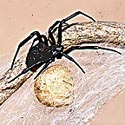|
Family: Theridiidae (comb-footed
spiders, button spiders, widow spiders)
Life
> Eukaryotes
>
Opisthokonta >
Metazoa
(animals) > Bilateria > Ecdysozoa > Panarthropoda > Tritocerebra >
Arthropoda > Arachnomorpha > Cheliceriformes > Chelicerata > Euchelicerata
> Arachnida > Araneae
> Araneomorpha
The Theridiidae or comb-footed spiders is a
large and diverse family represented by 15 genera in South Africa. They are
nocturnal, web-living spiders. The females vary from 7-16mm body length and the males 2.5-5mm. Females
all have the typical spherical-shaped abdomen and long, slender legs.
Comb-footed spiders have comb or serrated setae (hairs) on the hind
tarsi (feet). They construct 3-dimensional webs with numerous strands radiating from the
web to the ground. The lower sections of silk strands are coated in glue droplets. When an
insect wanders into one of these, the strand breaks off and the prey is lifted up to where
the spider will bite it, wrap it in silk and remove it to its lair and eat at leisure.
Various sized prey is caught in this manner.
Some of the genera indigenous to southern Africa
Latrodectus (button spiders, widow spiders)
This is a notorious genus in that certain species are highly toxic and,
under rare circumstances, can kill people if they are bitten. There
are 6 species in South Africa, 5 of which occur in the Western Cape. The very common
species, Latrodectus geometricus, or Brown
or Geometric button spider occurs around every home but fortunately a bite
from this species is not life threatening. On the other hand,
Latrodectus
indistinctus, or the Black button spider presents a serious problem. Its
venom is neurotoxic (affects the central nervous system). This spider does
not occur around the Cape Peninsula but distribution starts from about
Bellville and extends north and east. |
 |
Steatoda (false button spiders)
Colour ranges from brown to black with a white to yellow crescent marking on
the anteriodorsal (front top) side of the abdomen. These spiders are
harmless to man and occur under stones and bark or hollows in walls and are
sometimes found in the home. Certain colour forms can be mistaken for true
button spiders. |
 |
Text and images by Norman Larsen
© |
